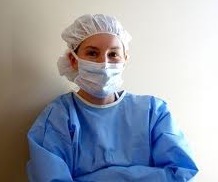Prevention and Prophylaxis
|
Isolation
Preventing the transmission of infectious microorganisms from infected or colonized
patients to other patients and health care workers must be a priority in the
ED. The Centers for Disease Control and Prevention, post exposure prophylaxis and Hospital Control Practices
Advisory Committee�s recommendations for isolation are reviewed below.
- Standard Precautions have replaced "universal precautions" and apply to all patients.
Standard precautions stipulate that gloves should be worn when touching blood, bloody
fluids, secretion (other than sweat), mucous membranes, or nonimpact skin. Hands
should always be washed after touching a patient and after removing gloves. (Of note
are observational studies demonstrating compliance with hand washing by health care
workers to be < 50%.) Chorhexidine and isopropyl alcohol are superior to soap and
water in removing transient flora from the hands. Chlorhexidine additionally provides
a residual antibacterial effect. Gowns, face shields, and/or eye protection are recommended
for procedures or activities that are likely to generate a splash of blood, bloody
fluids, secretions, or excretions.

| Table: Isolation guidelines for selected conditions |
|---|
| |
| |
| Standard Precautions | To be used for all patients |
| Airborne Precautions |
Tuberculosis - pulmonary, laryngeal
(suspected or confirmed)
Varicella/Zoster virus - chickenpox
Herpes zoster - disseminated
Herpes zoster - immunocompromised patient
Rubeola (measles) |
| Droplet Precautions |
Adenovirus
Epiglottitis (H. influenzae in children)
Diphtheria
Influenza
Meningitis (suspected bacterial)
Menigococcal disease
Mumps
Mycoplasma pneumoniae
Parvovirus B 19
Pertussis
Plague (pneumonic)
Rubella
Streptococcal (group A) pneumonia, pharyngitis, scarlet fever |
| Contact Precautions |
Abscesses
Encephalitis
Gatroenteritis (including C. difficile)
Herpes simplex
Impetigo
Lice or scabies
Multidrug resistant organism (including VRE)
Respiratory syncytial virus
Rubeola
Varicella/Zoster virus - Herpes zoster - localized
Wound infections |
| Vancomycin resistant Enterococci |
- Airborne precautions, in addition to standard precautions, are required for all patients
known or suspected to be infected with a pathogen that is transmitted by the
airborne route. Droplet nuclei (particles =5 �m) or dust particles containing
the infectious agent are produced when an infected patient coughs, sneezes, or
speaks. These particles may remain suspended in the air and travel long distances.
Airborne precautions mandate a private room with negative pressure and a closed
door. All visitors must wear an approved respirator mask (N95) that is fit tested. Transporting
the patient out of a negative pressure room should be minimized and the
patients must wear a standard surgical mask when outside of the room. Patients infected
with the human immunodeficiency virus presenting with pneumonia,
i.e., cough, fever, and pulmonary infiltrates on chest radiographs, should be placed in
respiratory isolation until pulmonary tuberculosis can safely be excluded.
- Droplet precautions, in addition to standard precautions, are implemented for all patients
known or suspected of having an infectious illness transmitted by droplets, i.e., large
particles that do not remain suspended in the air. Droplets are produced when
infected patients talk, cough, or sneeze. The droplets generally travel no farther than 3
feet. These patients require a separate room but do not require negative pressure or air filtering. A regular surgical mask should be worn by visitors or health care workers when
they enter the patient�s room and by the patient when transported outside of the room.
- Contact precautions are required for patients known or suspected of being infected
or colonized by organisms that are spread by direct contact, or by contact with contaminated
surfaces. Patients requiring contact isolation also require standard precautions.
These patients require a private room with strict disinfection of all equipment
after use. Barrier precautions, such as gloves and gowns, are used to prevent contamination
of exposed skin and clothing.
|
|